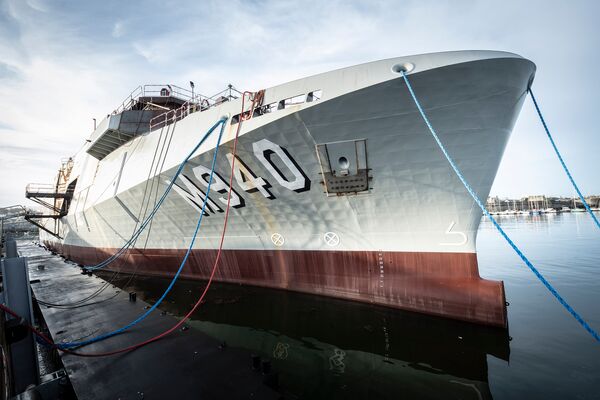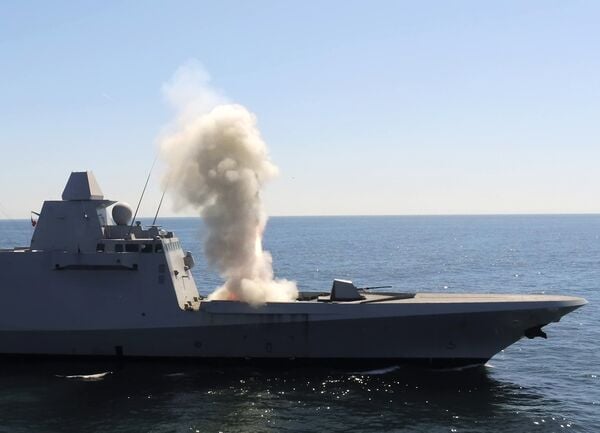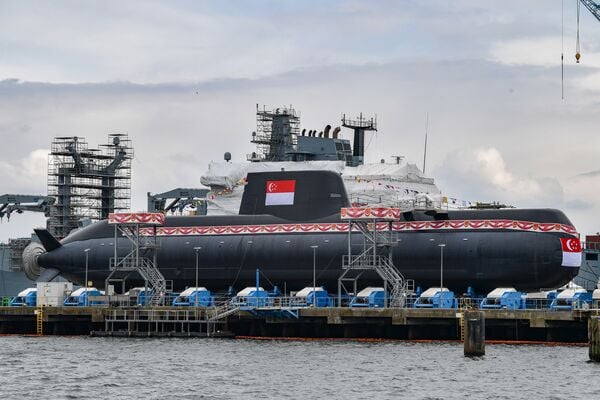- About
- Intara
- Capabilities
- Advisory
- Resources
- News
- Store
Naval Group launches first new Belgian MCMV, lays down third
31 March 2023
by Kate Tringham & Guy Toremans


Naval Group launched the Belgian Navy's first new mine countermeasures vessel, named Oostende (M 940), at Piriou shipyard in Concarneau, France, on 29 March. (Naval Group)
French shipbuilder Naval Group launched the first of 12 mine-countermeasures vessels (MCMVs) on order for the Belgian and Netherlands (BE/NL) navies and laid the keel for the third ship during a ceremony at Piriou shipyard in Concarneau, France, on 29 March.
First-of-class Oostende (M 940) and third ship Tournai (M 941) are the first two ships of the new City class that are destined for the Belgian Navy under the joint BE/NL next-generation offboard MCM replacement (rMCM) programme.
The Belgian-led rMCM programme is being delivered by Belgium Naval & Robotics – a consortium of Naval Group and Exail (formerly ECA Group) – under a contract awarded in May 2019. The contract includes the supply of 12 2,800-tonne displacement mother ships (six for each navy) and an MCM ‘toolbox' totalling around 100 unmanned or autonomous systems that will equip the vessels.
USN secretary calls for increased immigration to augment US shipbuilding labour
24 April 2024
by Michael Fabey


US Secretary of the Navy Carlos Del Toro said the country needs more blue-collar workers to meet navy shipbuilding needs at yards like Newport News Shipbuilding, shown here. (Janes/Michael Fabey)
To address the shortage of workers needed to build the number of ships needed to meet US Navy (USN) fleet plans, the country should seek to bring in more legal immigrants from foreign shores, according to US Secretary of the Navy Carlos Del Toro.
While acknowledging the impact of Covid-related issues on USN shipbuilding schedules on 23 April during an event at the Stimson Center, Del Toro said, “The bigger problem is the lack of blue-collar workers.”
Del Toro called on US lawmakers to “increase the amount of legal immigration” and work visas for potential shipbuilding work to come into country, despite the political divisions preventing such bipartisanship.
“We need to open up the spigot on legal immigration and allow blue-collar works to come here,” he said.
He underscored the need for retraining the new workforce for shipyard trades needed to build USN ships.
French Navy conducts first synchronised firing of MdCN naval cruise missile
23 April 2024
by Kate Tringham


MdCN is launched from the FREMM frigate Aquitaine on 18 April. (French Navy)
The French Navy has successfully conducted its first simultaneous test launch of the Missile de Croisière Navale (MdCN)naval cruise missile from a frigate and a submarine.
The test-firing was carried out by the service's lead multimission (FREMM) frigate Aquitaine, positioned off the coast of Brittany, and one of its Suffren (Barracuda)-class nuclear-powered attack submarines (SSNs), located off the coast of Biscarrosse, on 18 April, the Ministry of Armed Forces of France confirmed the same day.
During the test the two vessels launched a co-ordinated strike against a ground target located at the DGA's Biscarrosse missile test centre at Landes in southwestern France – with both missiles engaging their target “in perfect synchronisation”, the Ministry of Armed Forces of France said.
In a statement issued the same day the French Navy said the test was carried out in operational conditions to strengthen the operational know-how and combat skills of the service.
Singapore launches final Type 218SG submarine
23 April 2024
by Ridzwan Rahmat


Singapore's fourth Type 218SG submarine, seen here before its launch ceremony on 22 April 2024. (Singapore Ministry of Defence)
German shipbuilder ThyssenKrupp Marine Systems (TKMS) has launched the last of four Invincible-class (Type 218SG) air-independent propulsion (AIP)-equipped diesel-electric submarines (SSKs) on order for the Republic of Singapore Navy (RSN).
The vessel, which will be known in service as RSS Inimitable once commissioned, was launched on 22 April at TKMS' facilities in Kiel, Germany, the Singapore Ministry of Defence (MINDEF) announced in a statement on the same day.
“Conceptualised and engineered jointly by the RSN, Defence Science and Technology Agency (DSTA), and industry partner TKMS, the Invincible-class submarines are customised for operations in Singapore's shallow and busy tropical waters, and they possess longer endurance and higher payloads,” read the statement.
“Following the launch, Inimitable will undergo a series of sea trials before delivery to Singapore,” the ministry added, further disclosing that the second-of-class SSK that was launched in 2022, Impeccable , is still undergoing a series of local sea trials with plans to fully operationalise and commission it in 2024.
French shipbuilder Naval Group launched the first of 12 mine-countermeasures vessels (MCMVs) on orde...
Latest Podcasts
Iran Israel analysis
In this podcast Janes analysts discuss the Iranian attacks on Israel on the 14 April. They highlight the military systems used by Iran and the performance and impact of these on Israel. They also discuss the implications of this attack goi...
Listen nowJanes Case Studies
Using Janes Intara to build a common intelligence picture: Russian build up on the Ukrainian border
View Case StudyNews Categories
 Sea Details
Sea Details